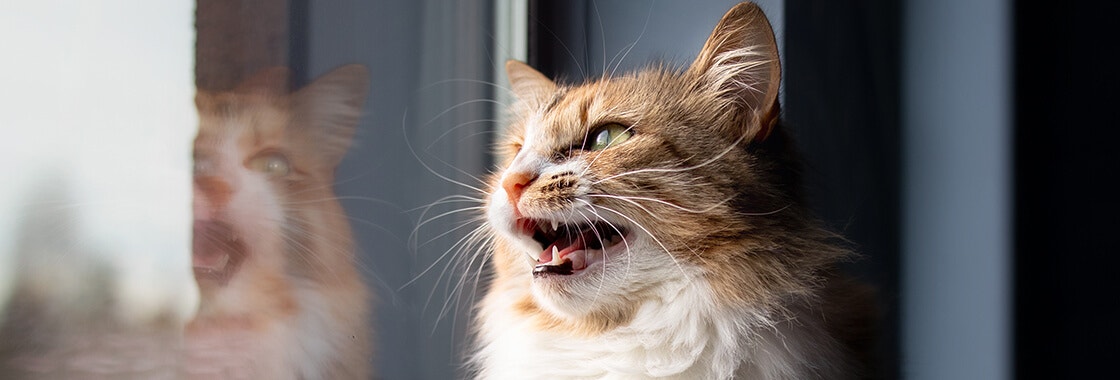- Homepage
- Blog
- Bonding & Care
- What Do Different Cat Noises Mean
Exploring cat noises: The secret language


Share
Our cats are always talking to us. The various meows, purrs, chirps, and other cat noises may not seem especially meaningful at first. However, just like people, cats consciously use their voices to communicate their feelings and let us know how they’re doing. Pay attention, and you can develop a better understanding of what your cats are trying to get across, become more in-tune with their needs, and develop a stronger bond with them.
If you’ve ever found yourself struggling to figure out what all that meowing is about, or wondered “why is my cat making weird noises?” then this post is for you. In this guide, we’ll take a closer look at the different noises a cat makes, and how to interpret them for a closer relationship with your cat.
What noise does a cat make?
Many first-time cat parents are surprised to learn their pet has a pretty wide vocabulary outside the usual meowing.
Here’s some of the common noises made by cats, and the meanings behind them.
Meowing: The most common of cat noises, meowing is generally used to communicate with humans, as opposed to with other cats. Cats first start meowing as kittens to communicate with their mothers, and as they grow, they begin using it for more or less the same purpose: to get your attention.
Generally, a cat meowing means they want something from you, whether that’s food, a stroke, or for you to open a door. Note that Oriental cat breeds tend to be very vocal, meowing louder and more frequently, and will make a distinctive noise compared to other breeds of cat.
Sometimes, a longer, drawn-out meow or a yowl can be a sign of distress, or physical discomfort from an illness. Yowls can also indicate that your cat wants to mate, or is concerned about another cat encroaching on their territory.
Purring: A cat’s soft, rumbling purr is usually an indicator that your cat is in a great mood, which is why it tends to be heard when they’re being petted or eating their favourite food. On rare occasions, some cats might purr when they’re worried.
You can distinguish this kind of “nervous purr” by looking at your cat’s body language. If they’re showing signs of agitation by sitting stiffly or folding their ears back on their head, this might be a sign they’re purring out of anxiety instead of contentment. Cats use subtle changes to their purr to convey different feelings. The better you know your cat, the better you’ll understand what the different sounds mean.
Hissing: What noise does a cat make when they’re feeling threatened? You’ll know it when you hear it. Accompanied by folded ears and narrow, angry eyes, a cat’s hiss is a sign of fear and aggression, showing that they feel threatened by something and are ready to fight if they need to.
Chirps and Trills: Sometimes, cats can make oddly bird-like noises best described as high-pitched chirps or trills. These are often made by mother cats in order to tell their kittens to follow them or pay attention. In a similar way, cats can use this noise to get your attention, or tell you about something they think is important.
Chatter: Cat chatter can lead many pet parents to wonder “Why is my cat making weird noises?” While chattering may not be the most common of cat sounds, a visibly moving, chattering jaw is perfectly natural and not a sign of distress. Sometimes accompanied by a faint, high-pitched meow, this sound lets you know a cat’s predatory instincts are kicking in, and is often observed when they spot a bird or a squirrel outside.
What are the 5 sounds cats make?
The five common cat noises are meowing, purring, yowling, hissing, and growling. These generally convey a need for attention, pleasure, distress, feeling threatened, and aggression respectively. Learn more with our articles on why do cats purr and cat yawning, or read on if you’ve observed a cat making weird noises.
Why is my cat making weird noises?
Cats can be vocal creatures, capable of making a range of sounds. Occasionally, you may notice cats making noises that seem a little out of the ordinary, and wonder what these mean.
When you first notice a cat making odd sounds, the first step is to research positive or neutral noises a cat might make. It could be that your cat making strange noises isn’t anything to be worried about at all, for example chattering, which could indicate excitement and a desire to hunt.
Unfortunately, some cats’ noises can be the indication of something more concerning, such as illness or pain. Cats can often make strange vocalisations when they’re feeling physical discomfort, such as long, drawn-out yowls. This kind of sound can also be caused by mating behaviours in cats that haven’t been spayed or neutered. Female cats in heat will often yowl loudly to attract male cats, while males will make a similar noise when they sense a female in heat. During mating, or a fight between two males, you might hear distant cats making high-pitched, distressed screams.
Strange noises can also be a sign of emotional distress, such as random snarls and growls. This usually indicates there’s another animal in the area that’s making the cat feel aggravated or threatened.
Whenever you notice your cat making strange sounds, it’s important to monitor their behaviour closely and look for other indicators as to how they’re feeling. For example, when cats wag their tails in a sharp, flicking motion, this can indicate that they’re aggravated by something in their environment.
Strange noises accompanied by behavioural changes, such as vomiting and diarrhoea, lethargy, and shifts in appetite, could be a sign of illness or dietary deficiency which needs to be checked with a vet.
If you notice persistent strange noises accompanied by behavioural changes which might be a sign of poor physical health, be sure to contact your vet. They’ll be able to shed more light on why your cat might be making strange noises, and ensure any potential health issues don’t go untreated.
What are happy cat noises?
Common happy cat noises include purring, trills, chirps, soft meows, and mews. These are typically heard when cats are doing something that makes them feel content or relaxed, such as eating, playing, or being petted. Read our guide “why do cats lick you” for more on cat behaviour.
Final thoughts
Cats can make a wide range of vocalisations, ranging from content meows and purrs to noises that sound more than a little odd. If you’ve been wondering “what noise does a cat make when it’s happy/sad/etc”, we hope this guide has made it easier to interpret what your cat is trying to tell you, and become more in-tune with their behaviours for a stronger bond.
For more support on developing the relationship with your cat, be sure to check out our guide “How to get a cat to like you”.



